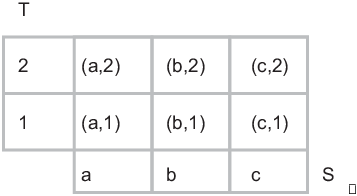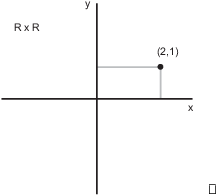Definition. Let S and T be sets. The Cartesian product of S and T is the set ![]() consisting of all ordered pairs
consisting of all ordered pairs ![]() , where
, where ![]() and
and ![]() .
.
Ordered pairs are characterized by the
following property: ![]() if and only if
if and only if
![]()
Remarks. (a) ![]() is not the same as
is not the same as ![]() unless
unless ![]() .
.
(b) You can define an ordered pair using sets. For example, the
ordered pair ![]() can be defined as the set
can be defined as the set ![]() .
.
Example. Let ![]() and
and ![]() . List the
elements of
. List the
elements of ![]() and sketch the set.
and sketch the set.
![]()
Notice that S and T are not subsets of ![]() . There are subset which "look like" S and
T; for example, here's a subset that "looks like" S:
. There are subset which "look like" S and
T; for example, here's a subset that "looks like" S:
![]()
But this is not S: The elements of S are a, b, and c, whereas the elements of the subset U are pairs.
Here's a picture of ![]() . The elements are
points in the grid:
. The elements are
points in the grid:

![]() consists of all pairs
consists of all pairs ![]() , where
, where ![]() . This is the same
thing as the the x-y-plane:
. This is the same
thing as the the x-y-plane:

Example. Consider the following subset of ![]() :
:
![]()
(a) Prove that ![]() .
.
(b) Prove that ![]() .
.
(a)
![]()
(b) Suppose ![]() . Then for some
. Then for some ![]() , I have
, I have
![]()
Equating the first components, I get ![]() , so
, so ![]() . But equating the second
components, I get
. But equating the second
components, I get ![]() , so
, so ![]() . This is a contradiction, so
. This is a contradiction, so ![]() .
.![]()
Example. ![]() is the set of pairs
is the set of pairs ![]() of integers. Consider the
following subsets of
of integers. Consider the
following subsets of ![]() :
:
![]()
Prove that ![]() .
.
Let ![]() . B consists of pairs whose
components add to an odd number. So I add the components of
. B consists of pairs whose
components add to an odd number. So I add the components of ![]() :
:
![]()
Since ![]() is odd,
is odd, ![]() is odd. This proves that
is odd. This proves that ![]() .
.![]()
You can take the product of more than 2 sets --- even an infinite number of sets, though I won't consider infinite products here.
For example, ![]() consists of ordered triples
consists of ordered triples ![]() , where a, b, and c are integers.
, where a, b, and c are integers.
Example. Consider the following subset of ![]() :
:
![]()
(a) Show that ![]() .
.
(b) Show that ![]() .
.
(a)
![]()
(b) Suppose ![]() . Then for some integers a and
b, I have
. Then for some integers a and
b, I have
![]()
Equating components, I get three equations:
![]()
But substituting ![]() and
and ![]() into
into ![]() gives
gives
![]()
This contradiction proves that ![]() .
.![]()
Copyright 2019 by Bruce Ikenaga